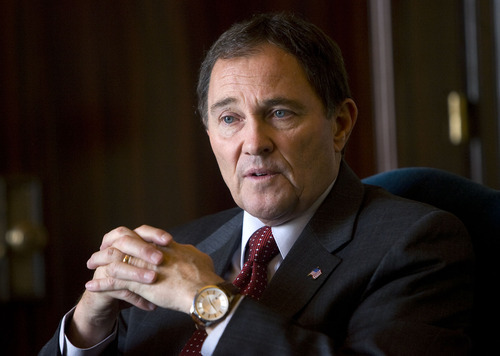This is an archived article that was published on sltrib.com in 2012, and information in the article may be outdated. It is provided only for personal research purposes and may not be reprinted.
One thing's for sure: Everyone wants to boost the number of Utah adults with college degrees or certificates to 66 percent by the year 2020.
The only questions are whether an ambitious plan to put Utah on that track will work and whether state leaders will be willing to pay for it.
Hundreds of lawmakers, education and business leaders gathered at Salt Lake Community College on Monday for the Governor's Annual Education Summit, where Gov. Gary Herbert and other leaders outlined a plan for how to get to that 66 percent — a goal experts say Utah must meet to keep its economy prosperous and fill future jobs. Now, nearly 43 percent of Utah adults go on to earn postsecondary degrees or certificates.
To boost that percentage, the Governor's Education Excellence Commission has set goals that 90 percent of third-, sixth-, and eighth-graders test proficient in math and reading; Utah's high school graduation rate swells to 90 percent; and 80 percent of Utahns enroll in programs to earn post-secondary degrees or certificates.
"It's not going to be easy, but it is absolutely a necessity," Herbert said. "We have work to do."
Leaders of the state's public education, higher education and applied technology college systems said Monday they will need more state dollars but will also work to innovate and change.
The state school board will ask that enrollment growth be fully funded and base per pupil spending, known as the weighted pupil unit, increase, among other requests. The Utah College of Applied Technology (UCAT) system will ask for funding with a goal of tripling the number of certificates it awards by 2020, said UCAT President Robert Brems. UCAT will also expand existing programs and create new ones, he said.
And higher education will ask lawmakers for an additional $20 million a year — which it will match with another $20 million — to serve more students and award more scholarships, said Dave Buhler, Utah Commissioner of Higher Education, among other moves.
Many praised the plan on Monday, but some also expressed concerns.
Rep. Patrice Arent, D-Salt Lake City, said the plan should address preschool education. Sen. Luz Robles, D-Salt Lake City, criticized it for not discussing class size or poverty issues, such as health care needs, which can undermine kids' educations. And Rep. Carol Spackman Moss, D-Holladay, said she's optimistic about the plan but was disappointed not to hear more specific discussion about how to raise money to pay for it.
And Sharon Gallagher-Fishbaugh, president of the Utah Education Association, urged leaders to slow down a bit, saying new programs take time to work and teachers must be able to keep up with all the changes.
Mark Bouchard, chairman of Prosperity 2020, a Utah business-led initiative that's been working closely with the governor's education commission, said the plan is not meant to be all-inclusive and it "will have to mature and evolve."
Bouchard said state leaders are still working out the specifics of exactly how much it will cost to implement the plan. But he said he's confident it can succeed.
"It's going to require a greater investment on our part to achieve this goal," Bouchard said, "but if we have an absolute plan that tells us how to get there and we understand what the investment means and we can measure that investment and our effectiveness, then we've done ourselves a great service as a state."



